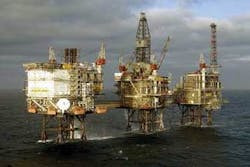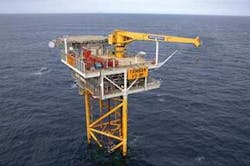Tie-ins, upgrades extend Ula lifespan
Nick Terdre, Contributing Editor
Ula fact file
Licensees
BP’s Ula field in the Norwegian sector of the North Sea has been in production for more than 20 years, but a series of measures now under way should keep it in production for another 20 years.
In the mid-1980s, during the first-phase development, the production operations staff was told the job would last some seven to 10 years, says Sigmund Prestegaard, field operations manager for Ula and its satellite, Tambar. On the 10th anniversary of startup in 1996, the company had extended its field life forecast by another 10 years. “On the 20th anniversary in 2006, we were looking at another 20 years,” says Prestegaard. “And we’re already thinking of how we might go beyond that.”
BP’s ambitious plans for Ula have not attracted the same publicity as its other current Norwegian projects - the Skarv field development in the Norwegian Sea and the redevelopment of Valhall, which, like Ula, is in the southern part of the North Sea. But in its own way Ula provides an object lesson in how recovery can be improved and production extended.
The field has been developed with three bridge-linked installations: a process platform connected to a drilling and wellhead platform and an accommodation platform. At sanction in 1980, total recoverable reserves were estimated at 435 MMboe. At end 2006, according to the Ministry of Petroleum and Energy, they stood at 565 MMboe, of which 84 MMboe remained to be produced.
The reservoir has responded well to water injection, which was introduced in the early years, and also to gas injection, which began in 1997. The decision to inject gas was prompted by the close of the Cod field, to which Ula gas was originally exported, and was taken in preference to building a second export pipeline.
This led on to the use of water-alternating-gas (WAG) injection, the first time BP had used the scheme in Norway. “We’ve built on this, and gradually learnt how to do it. We now use injection wells which can take both water and gas,” says Prestegaard.
Tambar
Another important contribution to keeping Ula going past its 20th anniversary was the development of the small Tambar oil and gas field, which is produced through an unmanned wellhead platform with two production wells. Tambar supplies gas for injection into Ula. When it came onstream in July 2001, BP said this would enable a further 20-22 MMbbl of oil to be recovered from Ula. Tambar’s own oil reserves were estimated at 45 MMbbl at start-up, but according to the Ministry of Petroleum and Energy, now stand at 54 MMbbl.
Tambar may soon acquire its own satellite. In 2003, BP was granted a license covering the Tambar East prospect which had been identified just a few kilometers away. In February, the jackupMaersk Guardian spudded an exploration well on Tambar East. If successful, the reserves will be produced by means of a well drilled from the platform. At 5,400 m (17,716 ft), it is within reach, and a platform well allows easier maintenance than a subsea well.
More gas should soon start flowing onto the Ula processing platform from Talisman’s Blane, the first third-party field to use the Ula facilities. Blane, which straddles the Norwegian/UK median line, is tied back to Ula by a 34-km (21.13-mi), 10-in. (25.4-cm) production line. In return, Ula will provide Blane with injection water via a 10-in. (25.4-in.) pipeline, and lift-gas for its two subsea production wells via a 6-in. (15.24 cm) line. A new riser has been installed to bring Blane production onto the platform, and a 450-metric-ton (496-ton) module to process it.
Ula gas upgrade
With Blane’s arrival, BP faced capacity restrictions on the Ula gas processing train. To deal with this bottleneck, the operator drew up the Ula Gas Upgrade project, which involves doubling gas-handling capacity to 120 MMcf/d. The Tambar and Blane licensees are participating in the project through a cost-sharing agreement. The new gas train will be contained in a 1,000-metric-ton (1,102-ton) module, under construction at the Rosenborg Verft yard in Stavanger. The module will be lifted onto the Ula processing platform in September by Saipem’sS7000 heavy-lift barge.
On arrival at the field the barge is also due to lift a 250-metric ton (275.58-ton) multi-phase pump module, again built by Rosenborg Verft, onto Tambar. The multi-phase pump has been supplied by Mann Turbo. By reducing back-pressure on the Tambar wells, the multi-phase pump will enable production to increase by 2,000-4,000 b/d and an additional 8-10 MMbbl to be recovered (the additional recovery is included in the overall reserves figure of 54 MMbbl given above).
In mid-year Tambar production will start flowing down a new multi-phase export pipeline laid in April by the Technip Offshore reelshipApache. In June the line was tied in and pressure tested. Installing a new line became necessary when the original line suffered hydrogen-induced stress cracking. The first line was built of stainless steel with a 16% chrome content to provide corrosion resistance, but it turned out that the cathodic protection system was not correctly engineered. For the new line, which uses the same material, the cathodic protection system has been adjusted.
After the original pipeline became unusable, BP found an interim solution to keep Tambar production flowing by putting it through the 10-in. (25.4-cm) Ula Gyda Interconnector Pipeline (UGIP), which was installed in 2001 when Tambar was being brought onstream so that excess gas from Ula could be exported to Gyda, then a BP asset. Fortuitously, the pipeline passes close by Tambar. It was converted for its new role in the fall of 2004. This involved installing a 60-m (196.84-ft) spoolpiece to connect a spare riser on Tambar to a pre-installed tee on UGIP.
To protect the line, which had not been designed to carry multi-phase flows, studies were mounted to determine the correct volumes of inhibitors to inject into the wellstream, and there have been no problems, says Prestegaard. The line has now been flushed and will be returned to its original purpose in September.
Extending facility life
Close communication is maintained with the authorities in planning and implementing measures to extend Ula’s producing life. The partners, Svenska Petroleum Exploration which holds 15% and Dong E&P Norge with 5%, also have been supportive. In 2004, the term of the main license, PL 019, was extended to 2028.
“Ula is one of a series of business opportunities we have identified,” says Prestegaard. “We’re succeeding, though it’s been a struggle to get the interfaces right.
“We haven’t done it as a major project like Valhall,” he adds. BP’s Valhall redevelopment project, which received government approval in June, involves a significant reconfiguring of field facilities, including the installation of a new processing and quarters platform and a shift from offshore power generation to the import of electricity from shore.
Whereas on Valhall the new platform will replace some of the field’s older facilities, on Ula it is necessary to refurbish the existing facilities to enable them to stay in operation for much longer than originally designed. “We carried out engineering groundwork studies in the early 2000s to establish what was needed to extend the life of the jackets and topside structures,” says Prestegaard. This work is now taking place, and all stages proposed so far have been approved by the Petroleum Safety Authority.
No changes are required to the jacket, but a series of measures are being implemented on the topsides. These include upgrades to the living quarters and the fire and gas systems and increased maintenance inspections and engineering. Lifts also are being installed on both the processing and quarters platforms - the latter has eight floors. Engineering is ongoing, and the intention is to have one of the lifts installed this year and the second in 2008.
The operational crew has been reduced to 60, even though there is now more plant to operate, as well as Tambar to take care of. The Tambar platform was planned with a low maintenance requirement of just one day’s visit a month.
Part of Ula’s accommodation capacity of 167 is no longer required, though there are extra personnel on the platform complex to implement the agreed modifications and hook up the new equipment. Although this is a “temporary” crew, they are likely to be present for up to 10 years implementing current projects, Prestegaard says. And by that time, further projects may well need implementing.
Renewing the organization
A lot of effort also is going into renewing the Ula organization, both offshore and onshore. “Obviously the people who got production going won’t be the ones turning out the lights,” Prestegaard says. The new intake is typically people in their mid 30s. “We’re putting a lot of effort into this,” he says. “We have a targeted recruitment program, and we’re taking on more apprentices.”
It is not only natural turnover that has to be compensated for - BP plans to recruit staff from the Ula and Valhall organizations to run Skarv, and these people will also have to be replaced.
BP has scoured the area around Ula and found little scope for additional reserves. But there could be more third-party business as smaller, newer oil companies position themselves to follow up exploration opportunities on nearby acreage. Later this year Dong, for example, plans to drill an appraisal well on the Oselvar discovery 23 km (14 mi) to the west and hopes to proceed with development. Ula and Gyda are potential hosts.
In Sept. 2008, a program of in-fill drilling is scheduled to begin on Ula, targeting the rim and cellar of the reservoir. First, BP plans to refurbish the Ula drilling rig, which is being used for wireline and coiled tubing operations. At present there are seven production wells, two water injection wells, and four WAG wells in operation. However, all the original 18 well slots have been used, and some reused, and recovering old slots is beginning to get expensive and/or risky, according to Prestegaard. Eventually, the answer could be a new wellhead platform, but so far this has not been assessed as cost-effective.
Measures are also under consideration to further improve Tambar recovery, including water and/or gas injection and in-fill drilling.


